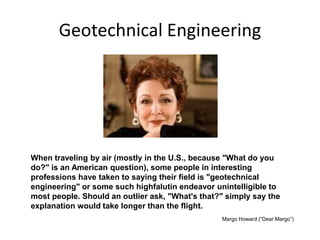More About Geotheta
More About Geotheta
Blog Article
Fascination About Geotheta
Table of ContentsAbout GeothetaNot known Details About Geotheta Top Guidelines Of GeothetaSee This Report on GeothetaThe Only Guide to Geotheta

They perform website investigations, collect samples, do laboratory examinations, and examine data to evaluate the suitability of the ground for construction tasks - Consulting Engineers. Based on their findings, geotechnical designers supply suggestions for structure layout, incline stability, retaining frameworks, and reduction of geotechnical risks. They team up with various other specialists, such as designers, structural engineers, and construction groups, to ensure that geotechnical considerations are incorporated right into the general task design and implementation
By assessing the behavior and buildings of dirt and rock, they can determine possible geotechnical dangers such as landslides, dirt negotiation, or incline instability. Their know-how assists prevent failures or accidents that can jeopardize lives and building. Right here are some in-depth tasks and responsibilities of a geotechnical designer: Website Examination: Geotechnical designers conduct site examinations to collect information on subsurface problems.
They translate the data to recognize the residential or commercial properties and actions of the soil and rock, including their stamina, leaks in the structure, compaction characteristics, and groundwater conditions. Geotechnical Evaluation and Design: Geotechnical engineers examine the information accumulated during site examinations to evaluate the security and viability of the website for building jobs. They perform geotechnical calculations and modeling to examine aspects such as bearing ability, negotiation, incline stability, lateral earth stress, and groundwater circulation.
Excitement About Geotheta
Structure Layout: Geotechnical engineers play a vital role in creating structures that can safely sustain the desired structure. They assess the soil conditions and tons demands to identify the appropriate structure type, such as superficial foundations (e.g., footings), deep foundations (e.g (https://www.abnewswire.com/companyname/geotheta.com_139529.html#detail-tab)., piles), or specialized techniques like dirt improvement. They consider aspects such as settlement limits, bearing capacity, and soil-structure communication to establish ideal foundation styles
They evaluate construction plans, screen site tasks, and conduct area assessments to confirm that the design referrals are adhered to. If unpredicted geotechnical concerns arise, they evaluate the situation and offer suggestions for remediation or changes to the style. Risk Analysis and Mitigation: Geotechnical designers evaluate geotechnical hazards and risks linked with the job site, such as landslides, liquefaction, or soil erosion.

Cooperation and Communication: Geotechnical engineers function closely with other experts associated with a task, such as designers, structural engineers, and building and construction groups. Efficient communication and cooperation are important to integrate geotechnical considerations into the general project style and building and construction process. Geotechnical designers supply technological competence, solution questions, and make sure that geotechnical demands are fulfilled.
The 6-Second Trick For Geotheta
Here are some types of geotechnical designers: Foundation Designer: Foundation designers focus on making and analyzing structures for frameworks. They evaluate the dirt conditions, load needs, and site attributes to establish one of the most appropriate foundation kind and layout, such as superficial foundations, deep structures, or specialized strategies like pile structures.
They examine the variables affecting slope stability, such as soil properties, groundwater conditions, and incline geometry, and develop strategies to stop incline failures and mitigate dangers. Quake Engineer: Earthquake engineers specialize in examining and developing structures to hold up against seismic pressures. They assess the seismic risk of a site, assess soil liquefaction potential, and create seismic style requirements to make certain the safety and resilience of structures during quakes.
They do area screening, accumulate examples, and evaluate the gathered data to characterize the soil residential properties, geologic developments, and groundwater problems at a site. Geotechnical Instrumentation Engineer: Geotechnical instrumentation engineers concentrate on tracking and measuring the behavior of soil, rock, and frameworks. They mount and preserve instrumentation systems that monitor aspects such as soil his comment is here settlement, groundwater degrees, slope movements, and structural displacements to examine efficiency and give very early warnings of potential issues.
The 45-Second Trick For Geotheta
They perform examinations such as triaxial examinations, consolidation examinations, straight shear tests, and leaks in the structure examinations to collect information for geotechnical analysis and layout. Geosynthetics Engineer: Geosynthetics engineers focus on the style and application of geosynthetic materials, such as geotextiles, geogrids, and geomembranes. They utilize these products to improve dirt security, reinforce inclines, give drainage services, and control disintegration.
They have a tendency to be investigative individuals, which means they're intellectual, reflective, and investigative. They are interested, systematic, rational, analytical, and rational. Some of them are additionally social, meaning they're kind, charitable, participating, person, caring, helpful, compassionate, tactful, and pleasant - Tailings Engineer.
In the workplace atmosphere, geotechnical engineers make use of specialized software program devices to execute estimations, develop layouts, and examine data. They prepare reports, review project specifications, connect with clients and staff member, and coordinate task tasks. The workplace setting offers a conducive environment for research, evaluation, and partnership with other specialists associated with the job.
Getting My Geotheta To Work
They regularly go to project websites to conduct website investigations, assess geotechnical problems, and gather information for analysis. These sees entail taking a trip to different places, often in remote or challenging surfaces. Geotechnical designers may do soil tasting, conduct tests, and screen construction tasks to guarantee that the geotechnical aspects of the job are being implemented correctly.
Geotechnical designers likewise function in specialized geotechnical laboratories. In these centers, they perform experiments, carry out examinations on soil and rock examples, and analyze the design homes of the materials. Geotechnical research laboratory designers work extensively in these settings, dealing with screening devices, running tools, and recording information. They work together with various other research laboratory personnel to make certain exact and dependable testing results.
Report this page